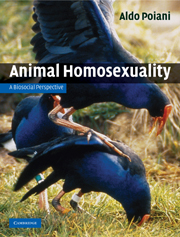Book contents
- Frontmatter
- Dedication
- Contents
- Contributors
- Acknowledgements
- Preface
- 1 Animal homosexuality in evolutionary perspective
- 2 The comparative study of homosexual behaviour
- 3 Genetics of homosexuality
- 4 Ontogenetic processes
- 5 The endocrine and nervous systems: a network of causality for homosexual behaviour
- 6 Immunology and homosexuality
- 7 Sexual segregation effects
- 8 The social, life history and ecological theatres of animal homosexual behaviour
- 9 Homosexual behaviour in primates
- 10 A Biosocial Model for the evolution and maintenance of homosexual behaviour in birds and mammals
- Appendix 1 Glossary
- Appendix 2 Predictions of the Synthetic Reproductive Skew Model of Homosexuality and results obtained in the comparative tests of the model carried out in birds and mammals
- Appendix 3 Comments on further results of comparative analyses of independent contrasts reported in the full correlation matrices of birds and mammals
- References
- Index
- Plates
1 - Animal homosexuality in evolutionary perspective
Published online by Cambridge University Press: 05 July 2014
- Frontmatter
- Dedication
- Contents
- Contributors
- Acknowledgements
- Preface
- 1 Animal homosexuality in evolutionary perspective
- 2 The comparative study of homosexual behaviour
- 3 Genetics of homosexuality
- 4 Ontogenetic processes
- 5 The endocrine and nervous systems: a network of causality for homosexual behaviour
- 6 Immunology and homosexuality
- 7 Sexual segregation effects
- 8 The social, life history and ecological theatres of animal homosexual behaviour
- 9 Homosexual behaviour in primates
- 10 A Biosocial Model for the evolution and maintenance of homosexual behaviour in birds and mammals
- Appendix 1 Glossary
- Appendix 2 Predictions of the Synthetic Reproductive Skew Model of Homosexuality and results obtained in the comparative tests of the model carried out in birds and mammals
- Appendix 3 Comments on further results of comparative analyses of independent contrasts reported in the full correlation matrices of birds and mammals
- References
- Index
- Plates
Summary
More often than not, great scientific journeys start with a paradox. For instance, Charles Darwin was intrigued by the non-reproductive castes of some insect species, to the extent of considering them a major obstacle to his theory of evolution by natural selection. In the sixth edition of The Origin of Species he wrote:
I will not enter on these several cases, but will confine myself to one special difficulty, which at first appeared to me insuperable, and actually fatal to the whole theory. I allude to the neuters or sterile females in insect communities: for these neuters often differ widely in instinct and in structure from both the males and fertile females, and yet, from being sterile, they cannot propagate their kind
(Darwin 1872a).The search for a resolution to Darwin’s sterile castes paradox produced a wealth of research that mainly took off in the 1960s and 1970s and that from the elegant William D. Hamilton’s formula (also known as Hamilton’s Rule) and John Maynard Smith’s concept of kin selection, through Edward O. Wilson’s impressive Sociobiology: The New Synthesis, has led us nowadays to Reproductive Skew Theory.
More than 80 years after Darwin’s formulation of his non-reproductive castes paradox, the ecologist George Evelyn Hutchinson (1959) was able to turn the apparently most trivial of questions: ‘Why are there so many kinds of animals?’ into a major evolutionary ecological paradox leading to the study and better understanding of the ecological processes, such as interspecific competition, that determine the structure and dynamics of natural communities. Over evolutionary time, such ecological processes can eventually produce character displacement and, ultimately, speciation.
- Type
- Chapter
- Information
- Animal HomosexualityA Biosocial Perspective, pp. 1 - 32Publisher: Cambridge University PressPrint publication year: 2010
- 1
- Cited by



